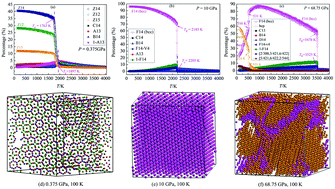Different structural transitions of rapidly supercooled tantalum melt under pressure†
Abstract
Molecular dynamics (MD) simulations have been performed to study the effects of pressure (P) on the crystallization of tantalum (Ta) under different pressures from [0, 100] GPa. The average potential energy of atoms in the system, the pair distribution function and largest standard cluster analysis (LSCA) have been employed to analyze the structure evolution. It was found that the solidified state at 100 K changes from the complex crystal (β-Ta) through the body-centered cubic (bcc) crystal (α-Ta) to the hexagonal close-packed (hcp) crystal with increasing pressure. At P ≤ 3 GPa, the favorable state is β-Ta, which is composed of Z12, Z14 and Z15 atoms, and crystallization starts at the same temperature of crystallization (Tc = 1897 K), while there is a stochastic relationship between the crystallinity and pressure. At P ∈ [3, 57.5] GPa, the melt is always crystallized into rather perfect α-Ta, and Tc is nearly linear to pressure. However, when P > 57.5 GPa, a quite perfect bcc crystal is first formed and then transforms to a hcp crystal via a solid–solid (bcc–hcp) phase transition. Moreover, if the new hcp atoms formed in the bcc stage are arranged in regular grains, the bcc–hcp transition would take a multiple-intermediate-state pathway else, a single-intermediate-state pathway is the possibilty. Additionaly, the parameter δs readily reflects the crystallinity of the β-Ta, and smaller the value of δs, higher is the crystallinity of the β-Ta. Finally, during the bcc–hcp transition under high pressure, the volume reduction is due to the rearrangement of atoms rather than the reduction in the atomic radius; a slight increase in the number of nearest neighboring pairs results in a significant increase of the system energy.



 Please wait while we load your content...
Please wait while we load your content...